Written by Bill on October 22, 2014 |
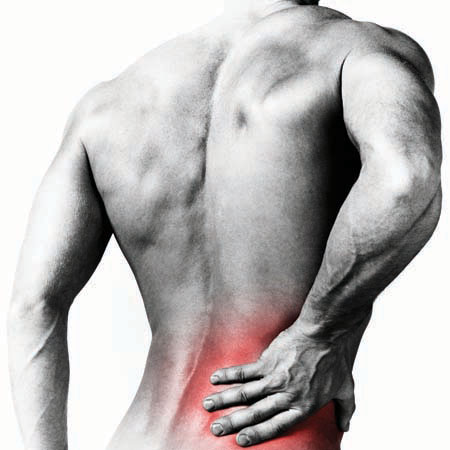 As a physical therapist, I often interact with patients who on their initial visit will comment, “I need exercises for my back” or “I just need to get my back stronger.” Although exercise and increased strength are vital in low back health, a common misconception is that low back pain is a homogenous entity, essentially the same from one individual to the next. I frequently use the analogy of a patient with chest pain being seen in the Emergency Room. If every patient that was seen for chest pain were treated for a heart attack, how successful would that treatment be? How would the patient with gastric reflux or a collapsed lung respond to medications, or even surgery, to treat blockage of the arteries of the heart? Obviously, the answer is “not very well.” As we expect physicians to realize that there are many different causes (and treatments) for chest pain, physical therapists also are increasingly aware that not all back pain responds favorably to the same treatment techniques or exercise.
As a physical therapist, I often interact with patients who on their initial visit will comment, “I need exercises for my back” or “I just need to get my back stronger.” Although exercise and increased strength are vital in low back health, a common misconception is that low back pain is a homogenous entity, essentially the same from one individual to the next. I frequently use the analogy of a patient with chest pain being seen in the Emergency Room. If every patient that was seen for chest pain were treated for a heart attack, how successful would that treatment be? How would the patient with gastric reflux or a collapsed lung respond to medications, or even surgery, to treat blockage of the arteries of the heart? Obviously, the answer is “not very well.” As we expect physicians to realize that there are many different causes (and treatments) for chest pain, physical therapists also are increasingly aware that not all back pain responds favorably to the same treatment techniques or exercise.
Continue Reading »
Written by Michael on October 8, 2014 |
This is part 2 of a 2 part series. Catch up on part 1.

A good dynamic warm up will get you ready for whatever sporting event you are going to do that day by targeting the tissues involved in that event. For example, if you are to go for a run, you would want to primarily warm up the calves, quads, glutes, and hamstrings. A dynamic warm up will not be the same for golf as it will be to go out for a run but they may contain some of the same components. The broad routine for a dynamic warm up should include soft tissue preparation, a general warm up and a specific warm up.
Continue Reading »
Written by Michael on October 1, 2014 |
This is part 1 of a 2 part series.

Do professional athletes warm up prior to their games and events? Absolutely, and you should too. Warming up prior to any workout or athletic event is essential for many reasons. A good warm up will increase blood flow to active muscles, improve muscle function by increasing strength and power as well as improving reaction time. Continue Reading »
Written by Michael on September 25, 2014 |
Every single person has some kind of muscle imbalance. A muscle imbalance is where one muscle is weak and the antagonist or opposite muscle is tight. These imbalances are one of the most common impairments that we as physical therapists see during evaluations. They often the result of habitual movements such as only working out certain muscle groups or doing repetitive motions, such as running, without cross training.
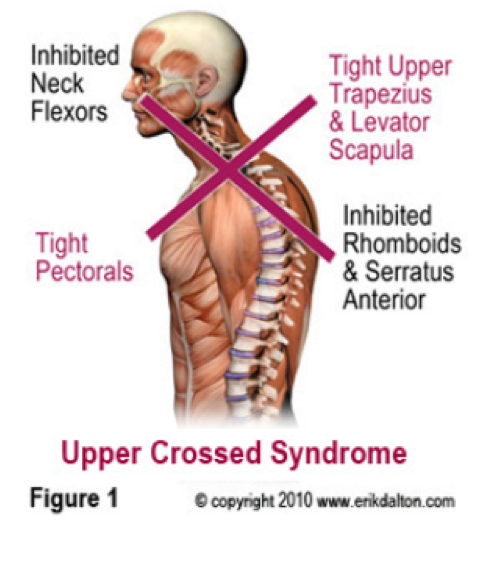 One primary cause of muscle imbalances is poor posture. People are working longer hours, staring at their computer screens for hours and hours. This causes muscle imbalances which can lead to neck pain. One of the most common types of muscle imbalances in the neck and shoulders is called “upper crossed syndrome.” This is where you have inhibited or weakness in the deep neck flexors in the front and rhomboids/lower traps in the back in combination with tightness of the upper traps/levator scapula and pectorals.
One primary cause of muscle imbalances is poor posture. People are working longer hours, staring at their computer screens for hours and hours. This causes muscle imbalances which can lead to neck pain. One of the most common types of muscle imbalances in the neck and shoulders is called “upper crossed syndrome.” This is where you have inhibited or weakness in the deep neck flexors in the front and rhomboids/lower traps in the back in combination with tightness of the upper traps/levator scapula and pectorals.
It is common to see these patients with a forward head posture and rounded back as seen in the above illustration.
In order to address these muscle imbalances, it is important to take quick, frequent rest breaks at your computer to relieve the tension in the tight muscles and engage the weak muscles. There are two simple exercises that you can perform at your desk during these 30 second breaks. The first is a scapular retraction where your pull your shoulders blades together and pinch back and down. The other is a chin tuck where you gently draw your chin back and slightly down towards your spine and chest. You can progress these exercises with holds and repetitions.
As always, if you ever have any questions regarding your unique condition or simple questions regarding these exercises, please come in to ask one of our therapists in Carlsbad, Vista, or 4S Ranch.
.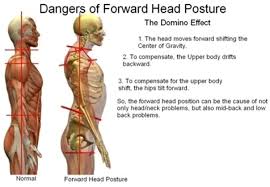
Written by Laura on June 18, 2014 |
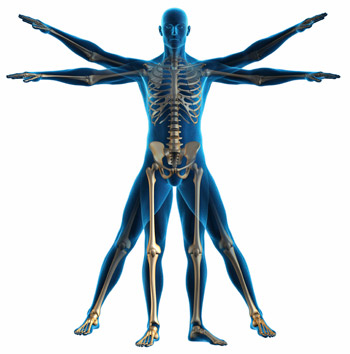 Starting therapy shouldn’t be a scary thing. Therapy is meant to decrease a patient’s symptoms and pain. It increases strength, improves mobility and functional tolerances. Therapy will allow you to return to what you want to do in your life. Physical Therapy (PT) is when health problems or impairments make it hard to move and function due to injury, surgeries, or pain. Physical therapist are trained to treat any body part, but there are also specialist (pediatric, neurological, TMJ, etc). This article will focus on the outpatient orthopedic setting. Occupational therapy (OT), in an outpatient setting, focuses on the upper extremity (specifically wrist, hand, and elbow). ProActive’s OTs are all certified hand therapist (CHT). A CHT is an OT or PT by profession with at least five years of experience, plus 4,000 hours of hand therapy practice (upper extremity rehabilitation), and passes a certification examination that demonstrates knowledge of all areas of hand therapy. The therapist are here to help you return to your ideal lifestyle.
Starting therapy shouldn’t be a scary thing. Therapy is meant to decrease a patient’s symptoms and pain. It increases strength, improves mobility and functional tolerances. Therapy will allow you to return to what you want to do in your life. Physical Therapy (PT) is when health problems or impairments make it hard to move and function due to injury, surgeries, or pain. Physical therapist are trained to treat any body part, but there are also specialist (pediatric, neurological, TMJ, etc). This article will focus on the outpatient orthopedic setting. Occupational therapy (OT), in an outpatient setting, focuses on the upper extremity (specifically wrist, hand, and elbow). ProActive’s OTs are all certified hand therapist (CHT). A CHT is an OT or PT by profession with at least five years of experience, plus 4,000 hours of hand therapy practice (upper extremity rehabilitation), and passes a certification examination that demonstrates knowledge of all areas of hand therapy. The therapist are here to help you return to your ideal lifestyle.
Continue Reading »
Written by Laura on June 13, 2014 |
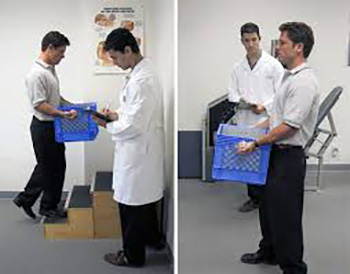
Industrial therapy is a type of rehabilitation aimed at helping injured workers return to work safely and effectively, avoid re-injuries, and to help with prevention and reduction of work-related injuries. We must remember that industrial does not automatically mean that it is labor intensive. It includes jobs that are repetitive or that may involve awkward positions or motions. This type of therapy may include some if not all of the following types of treatments/programs/tests: physical and/or occupation therapy (worker compensation focused), Functional Capacity Evaluations (FCE), Work Conditioning, Work Hardening, or Ergonomics.
Continue Reading »
Written by Laura on May 22, 2014 |
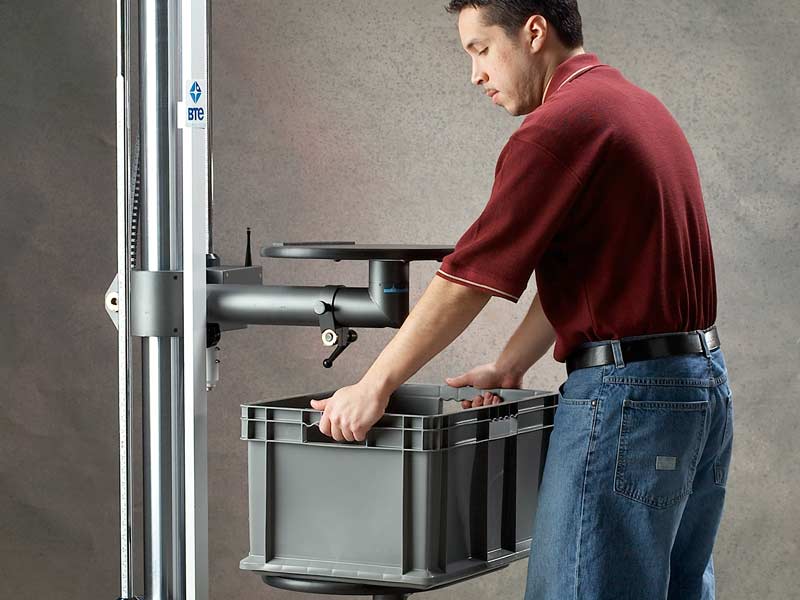
The POETs that occur in physical therapy have nothing to do with literature or rhyming. POET stands for post offer of employment testing or post offer employee testing. These tests are one of the most valuable injury prevention resources for both employees and their potential employers. This examination is given to a prospective employee to compare their physical capabilities to the physical demands required to perform the essential functions of the offered position. It ensures that an applicant is physically matched to the job they will perform, and is important for job success, injury prevention, and minimizing the associated costs with any chance of injury. The nice thing about a POET is that it truly benefits both the employee and employer.
More and more companies are using POETs. Companies don’t have to perform these tests for all of their jobs, but if they require a POET for a specific job then they need to test all applicants that apply for the specific job position. POETs are usually performed for jobs that require high physical demands or may be considered high risk occupations for injury. They can also be completed to get baseline data on an employee. Again they are used to safely match an applicant with the job being offered.
POETs occur after a conditional job offer has been made. They are usually performed at occupational health clinics, physical therapy clinics, or at the place of employment. Employers may have additional tests the employee must complete prior to employment (back ground check, drug test, and/or physical). Each POET is specific to the job and the employer. A formal job analysis will be performed; looking at heights of instruments and equipment, positions required for tasks, and the forces needed to grip, pinch, maneuver, push, pull, lift and/or carry to perform the job being analyzed. The heart rate is watched throughout the test for safety reasons; some companies may monitor an applicant’s blood pressure as well. An activity is usually performed at least 3 times so that companies can look at consistency and validity. It’s important that the applicant performs each test to their safe maximal effort. Realize that the employee normally will not be told if they pass or fail the test when the POET is completed. The clinician collects the data, and the employer or third party administrator analyze the data and compare it to the required physical demands. If the performed abilities don’t match the essential functions and physical demands, the job offer can be receded.
A POET shouldn’t scare any employee if they truly feel that they can perform the job they applied for, especially if they have already performed that type of work before. They should be relaxed, go in and perform the activities/tests to their best ability. Remember it’s just trying to ensure that an applicant is physically matched to the job they will perform, and is important to job success and injury prevention (keeping the employee safe).
Written by Jack on May 16, 2014 |

One of our employees came to me with a look of astonishment on her face. She says to me, “Jack, we are in the business of making people feel better. We have patients come to us every day who are in severe pain. In fact, at times the pain is so bad, they want to “give up”. Well Jack, I watched two videos that have and will forever inspire me.” This employee caught my attention, so I put my work aside and without hesitance said, “I want to watch these videos now!”
The following two videos are about dogs, and that is all I am going to tell you.
Continue Reading »
Written by Jack on May 8, 2014 |

We really take our comment card results seriously. Not only do we look at each and every comment card, we tally up the results, too. We give all our patients the opportunity to mail in their cards to a P.O. Box, allowing them to give their honest opinions. Here are the first quarter 2014 results:
Total number of cards returned: 74
Continue Reading »
Written by Nate on April 30, 2014 |
Posture – The way in which your body is positioned when you are sitting or standing.
Effects of Poor Posture
- Poor posture makes you look older than you are
- Hunched shoulders and sagging faces are signs of aging
- Poor posture limits your range of motion
- Muscles and ligaments adaptively shorten or lengthen which decreases your ability to move
- Poor posture can increase your pain or discomfort
- Headaches, extremity pain and nerve involvement are common
Continue Reading »
 As a physical therapist, I often interact with patients who on their initial visit will comment, “I need exercises for my back” or “I just need to get my back stronger.” Although exercise and increased strength are vital in low back health, a common misconception is that low back pain is a homogenous entity, essentially the same from one individual to the next. I frequently use the analogy of a patient with chest pain being seen in the Emergency Room. If every patient that was seen for chest pain were treated for a heart attack, how successful would that treatment be? How would the patient with gastric reflux or a collapsed lung respond to medications, or even surgery, to treat blockage of the arteries of the heart? Obviously, the answer is “not very well.” As we expect physicians to realize that there are many different causes (and treatments) for chest pain, physical therapists also are increasingly aware that not all back pain responds favorably to the same treatment techniques or exercise.
As a physical therapist, I often interact with patients who on their initial visit will comment, “I need exercises for my back” or “I just need to get my back stronger.” Although exercise and increased strength are vital in low back health, a common misconception is that low back pain is a homogenous entity, essentially the same from one individual to the next. I frequently use the analogy of a patient with chest pain being seen in the Emergency Room. If every patient that was seen for chest pain were treated for a heart attack, how successful would that treatment be? How would the patient with gastric reflux or a collapsed lung respond to medications, or even surgery, to treat blockage of the arteries of the heart? Obviously, the answer is “not very well.” As we expect physicians to realize that there are many different causes (and treatments) for chest pain, physical therapists also are increasingly aware that not all back pain responds favorably to the same treatment techniques or exercise.



 One primary cause of muscle imbalances is poor posture. People are working longer hours, staring at their computer screens for hours and hours. This causes muscle imbalances which can lead to neck pain. One of the most common types of muscle imbalances in the neck and shoulders is called “upper crossed syndrome.” This is where you have inhibited or weakness in the deep neck flexors in the front and rhomboids/lower traps in the back in combination with tightness of the upper traps/levator scapula and pectorals.
One primary cause of muscle imbalances is poor posture. People are working longer hours, staring at their computer screens for hours and hours. This causes muscle imbalances which can lead to neck pain. One of the most common types of muscle imbalances in the neck and shoulders is called “upper crossed syndrome.” This is where you have inhibited or weakness in the deep neck flexors in the front and rhomboids/lower traps in the back in combination with tightness of the upper traps/levator scapula and pectorals.
 Starting therapy shouldn’t be a scary thing. Therapy is meant to decrease a patient’s symptoms and pain. It increases strength, improves mobility and functional tolerances. Therapy will allow you to return to what you want to do in your life. Physical Therapy (PT) is when health problems or impairments make it hard to move and function due to injury, surgeries, or pain. Physical therapist are trained to treat any body part, but there are also specialist (pediatric, neurological, TMJ, etc). This article will focus on the outpatient orthopedic setting. Occupational therapy (OT), in an outpatient setting, focuses on the upper extremity (specifically wrist, hand, and elbow). ProActive’s OTs are all certified hand therapist (CHT). A CHT is an OT or PT by profession with at least five years of experience, plus 4,000 hours of hand therapy practice (upper extremity rehabilitation), and passes a certification examination that demonstrates knowledge of all areas of hand therapy. The therapist are here to help you return to your ideal lifestyle.
Starting therapy shouldn’t be a scary thing. Therapy is meant to decrease a patient’s symptoms and pain. It increases strength, improves mobility and functional tolerances. Therapy will allow you to return to what you want to do in your life. Physical Therapy (PT) is when health problems or impairments make it hard to move and function due to injury, surgeries, or pain. Physical therapist are trained to treat any body part, but there are also specialist (pediatric, neurological, TMJ, etc). This article will focus on the outpatient orthopedic setting. Occupational therapy (OT), in an outpatient setting, focuses on the upper extremity (specifically wrist, hand, and elbow). ProActive’s OTs are all certified hand therapist (CHT). A CHT is an OT or PT by profession with at least five years of experience, plus 4,000 hours of hand therapy practice (upper extremity rehabilitation), and passes a certification examination that demonstrates knowledge of all areas of hand therapy. The therapist are here to help you return to your ideal lifestyle.


